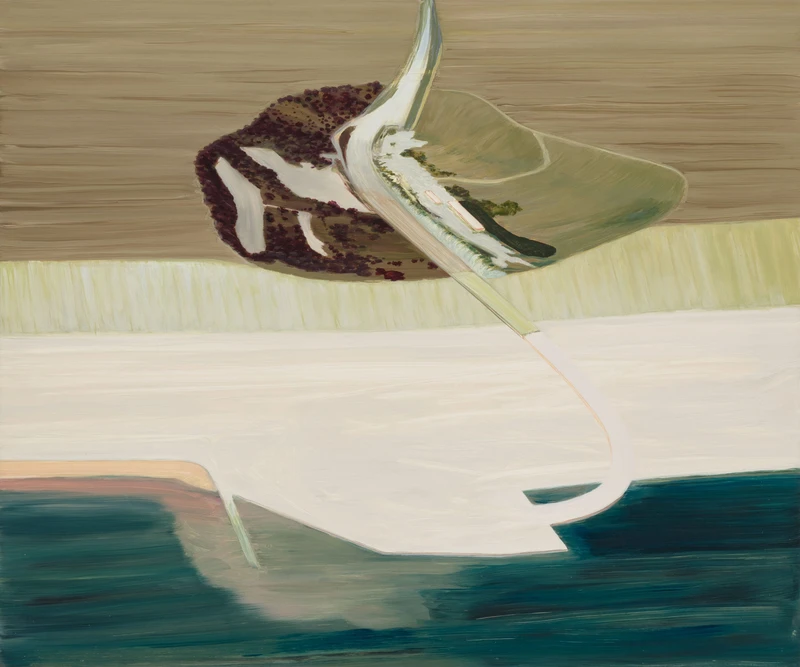Carol Rhodes: Sites
7 Jun-9 Aug 2025


Alison Jacques presents Sites, a solo exhibition of work by the Scottish artist Carol Rhodes (b.1959; d.2018). Spanning nearly 20 years, many of the exhibited works have never been seen in London. In 1994, Rhodes began a body of highly distinctive paintings, which she proceeded to develop over two decades, until motor neurone disease made it finally impossible for her to paint and draw. Since her death in 2018, the significance of these works has been increasingly recognised. Drawing on recent research in her archive, this exhibition sets up specific pairings of paintings and drawings dating from 1995 to 2014 to illustrate the richness, specificity and psychological depth of her practice. This exhibition runs parallel to Rhodes participating in A Living Collection, The Hepworth Wakefield and Fake Barn Country, Raven Row, London.
Rhodes’s paintings are aerial views of fictional, post-industrial edge-lands; land interrupted by excavations, depots, industrial units, motorways and business parks, and sometimes bordered by the sea. Rhodes described her subject matter as being ‘in-between places’ and ‘non-places’ – places without history that were normally disregarded or hidden. The aerial viewpoint she employed was not, however, merely a formal device; it had very personal resonances. Being remote was not just to do with distance, it was a state of mind:
The thing about being up high is that you can see a lot. And the higher up you go, the more you can see. The more terrain that is opened up for us to see, the easier it is to understand what happens below and so it gives us a feeling of security and control. But if you go too high, there is a line that, when crossed, changes that into an agoraphobic panic. I would like my pictures to be on that line… the line between security and unease.
Rhodes felt that to look down was to see something that was ‘already over’. It induced what she described as a sort of nostalgia she connected to her peripatetic upbringing. Growing up in India, she moved to England when she was fourteen, and soon afterwards to Scotland, where she lived and worked for the rest of her life. A lasting sense of displacement and estrangement fed into her work in a very deep way. Rhodes’s working practice was detailed and very carefully planned:
I get an idea, a notion or a feeling that on the one hand is extraordinary vague but it has got a very strong core. Then I look through a lot of different photographs in the books I’ve got in the studio and flesh that out, little bits from different images, it can be tiny portions from a huge array of different photographs. Then I pin down the thing that was in my mind and spend a lot of time drawing it out.
The distance from which she depicted her views was, she said, in contrast, or even contradiction, to the specificity with which she painted them. The importance of imposing intention and function onto the substance of paint was crucial for her; was the grass dry, wet, long, short? Was the soil sandy or chalky? She wanted water to be opaque, very much a surface. Such specificity extended to clear references to social geography and the real impact of human intervention on the natural environment. But the land in Rhodes’s paintings can also be read metaphorically, for example, as a wounded body. Organs, muscles, veins, skin and bones are continually suggested. ‘These are portraits of landscapes’, she once wrote.
Rhodes’s use of colour was distinctive and particular. Annotated strips of paper used as bookmarks record the page numbers in books in which a particular colour, or the resonance, or sum, of colours and tones on the printed page, had caught her attention. Also important were the remembered colours of her Indian childhood and those of historical paintings. An especially strong influence was 14th and 15th century Sienese painting and the concurrence of this exhibition with Siena: The Rise of Painting at the National Gallery would have delighted her.
One of the first exhibitions to bring wider attention to Rhodes’s work was titled The Persistence of Painting (CCA, Glasgow, 1995). Painting has always persisted and Rhodes’s sense of that, and her contribution to its continuity, reminds us that the only landscapes we have – the only reality – are that which we ourselves create.
Carol Rhodes was born in Edinburgh in 1959. After graduating from Glasgow School of Art in 1982, she stopped painting for nearly ten years, focusing on social and political activism, including the anti-nuclear and women’s movements. She started painting again in 1992 and her work began to be exhibited regularly from 1994. A mid-career survey of Rhodes’s work was presented at the Scottish National Gallery of Modern Art in Edinburgh in 2007. Recent institutional surveys include MAC Belfast, Kettle’s Yard, Cambridge; Kelvingrove Art Gallery and Museum, Glasgow; Bonnefantenmuseum, Maastricht and Haus am Waldsee, Berlin.
Rhodes’ work has been acquired by major museums including Tate, London; National Galleries of Modern Art, Edinburgh; Bonnefantenmuseum, Maastricht; Yale Center for British Art, Connecticut; and The Hepworth Wakefield.
Carol Rhodes: Sites press release
Download